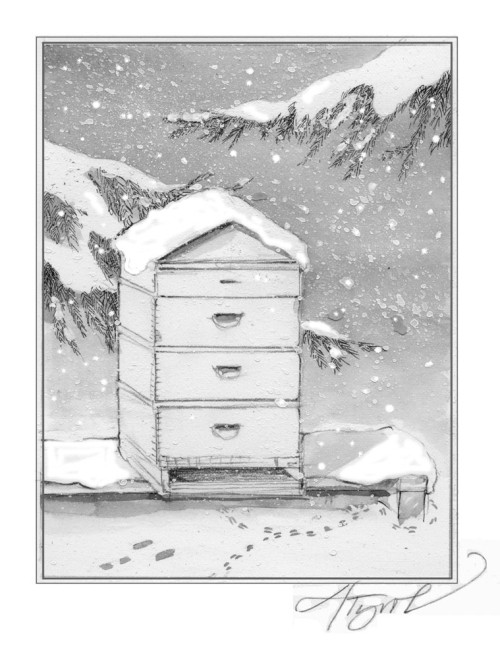
As the landscape settles into winter, one of the things we notice (and likely enjoy) is the virtual absence of insects. As small, cold-blooded creatures, insects cannot stay active at low temperatures; they quickly chill, their metabolism stops, and they freeze to death.
To escape an icy demise, insects in northern latitudes employ many tactics for winter survival, such as overwintering as freeze-resistant eggs, or fortifying their bodies with natural antifreezes and hiding in protected crevices.
Not so the honeybee, a familiar, non-native insect that made its way to the Americas via settlers in 1622. Honeybees are native to Africa, and adhering to their warm-latitude origins, remain active all winter. Individually, they’d stand no chance against months of subfreezing weather, but as a collective, they’ve developed several extraordinary ways to survive in cold northern climes.
In the Northeast, a honeybee’s preparation for winter begins with the first flowers of spring, but this process accelerates as summer wanes. The collection of fall nectar, most notably from goldenrods and asters, can be essential to the colony’s winter survival. The average hive may need 60 or more pounds of honey to get through a northern winter.
Another crucial late-summer process is the production of winter bees, bees with a different blood protein profile and greater body fat than their summer bee counterparts. The winter bees get the colony through winter, while the summer bees, the ones that so diligently foraged for nectar and nursed the developing winter bees, die off in the fall. Beginning in September, the colony also rids itself of drones, male bees whose only role is to mate with new queen bees. All drones are forced out to starve. Lastly, the colony stops producing new bees, as eggs and larvae require temperatures of 90oF to 96oF to develop.
As flowers disappear and temperatures fall, bees stop foraging and remain in the hive. When the mercury falls below 64oF, bees begin a behavior known as clustering, where they gather together to form a ball that extends through several honeycombs in a typical hive. The cluster consists of an outer mantle of tightly-packed bees which surrounds an inner core of bees that are more loosely-packed and free to move about. The all-important queen bee is sequestered at the center.
As the temperature drops, the cluster becomes tighter and tighter, shrinking to one-fifth of its original size. At their most tightly-packed, the mantle bees form a layer that approaches fur in its insulating qualities. Bees become comatose if they chill below 43oF; thus, when their thorax temperature falls to about 54oF, the mantle bees exchange places with bees from the core. Mantle bees that get too chilled to return to the core drop off and die.
Once the temperature in the hive falls below 50oF, the cluster can only maintain its life-supporting interior temperature of 64 oF (at the periphery) to 90oF (center) by actively producing heat. Like mammals, the core bees begin to shiver by pumping their large flight muscles. This is why honey stores are critical. The bees eat honey and transform it into heat through metabolism. After they empty one honeycomb, the cluster slowly shifts sideways and upwards towards a full one.
This survival mode, however, has some inherent hazards. If there is not enough honey, or if it gets so cold that the bees cannot move to full honeycombs, the colony starves.
Eating honey, especially if it is high in indigestible material, leads to a need to void feces. Usually, this is taken care of when winter days warm above 50oF, allowing bees to leave the hive for cleansing flights during which they dot the snow with tiny yellow splashes. If prolonged cold stops bees from leaving the hive, they eventually defecate inside, and if enough bees do this, it leads to the death of the entire colony.
To make matters worse, metabolism produces water vapor as a byproduct, and this must be allowed to escape from the hive. Savvy beekeepers drill a hole near the top of the hive for this purpose. Otherwise, the vapor condenses and ice-cold water drips onto the bees, causing them to freeze to death. In the particularly bad and long winter of 2000-2001, many beekeepers in the northeast reported losses of 50 percent of their colonies. Some suffered losses of 90 percent.
One of nature’s marvels is the temperature achieved within a mere ball of bees in subzero weather. So take off your winter hat and put your ear to the thin wood of a hive; you’ll hear the humming of bees by the thousand. The sound is enough to transport you to summer meadows, even in the cold, dark depths of winter.

